The overlooked masterpiece full of coded messages about World War One
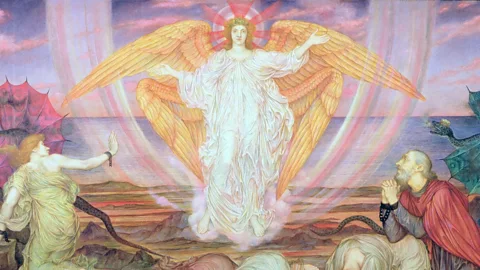 Trustees of the De Morgan Foundation
Trustees of the De Morgan FoundationEsoteric and pioneering, the paintings of a lesser-known Pre-Raphaelite, Evelyn De Morgan, explored the trauma and meaning of war – and prefigured current fantasy art.
On a rocky beach that glows red with lava, smoke-breathing dragons surround wretched-looking prisoners beseeching an angel to deliver them from suffering. The oil painting Death of the Dragon by Evelyn De Morgan looks at first like a scene from the New Testament's apocalyptic Book of Revelation. But, painted between 1914 and 1918, it's also something more personal and critical: an allegory for the misery and bondage of World War One, and the confrontation between good and evil.
The spectacular painting, measuring more than a metre high, is one of the highlights of a new exhibition, Evelyn De Morgan: The Modern Painter in Victorian London, at London's Guildhall Art Gallery, home to the City of London Corporation's art collection. On display are rarely seen works from the De Morgan Foundation, as well as two newly-restored paintings and two recreations, completed just last year, of works lost in an art warehouse fire in 1991.
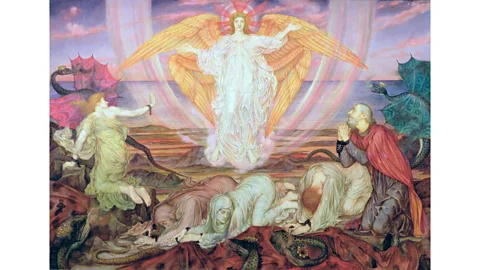 Trustees of the De Morgan Foundation
Trustees of the De Morgan FoundationThe show coincides with the reopening of the De Morgan Museum in Barnsley, Yorkshire, following an extensive roof renovation, and responds to a rising interest in this lesser-known artist. She has tended to be eclipsed by her husband William – a ceramicist and writer, who had worked early in his career with the textile designer William Morris – and the famous men in their circle: her uncle and art teacher, John Roddam Spencer Stanhope, for example, and the painters William Holman Hunt and Dante Gabriel Rossetti. Much of what we know about De Morgan today comes from her sister Wilhelmina, who set up the De Morgan Foundation, but even she saw fit to publish the couple's posthumous biography under the title William De Morgan and his Wife.
Yet, Evelyn De Morgan more than deserves the art world's belated acclaim. A Slade graduate, who was working at the tail end of the Pre-Raphaelite movement, she took the arguably twee or overly sentimental genre into new territory, creating tableaux that were unusually visionary and energetic. The women she portrayed were less passive than those depicted by her contemporaries, and featured as symbols of agency rather than objects of the male gaze. Instead of a drowned body floating down the river, as in Sir John Everett Millais' Ophelia, or figures whose main currency was their looks, we meet a skilled sorceress creating magical potions and flying superheroines who can cast rain, thunder and lightning from their fingers.
These goddess-like figures show the influence of the classical art that De Morgan had studied. Immaculately executed works such as Boreas and Oreithyia (1896) reveal her interest in mythology and her mastery of the human form, reminiscent of Michelangelo.
In Death of the Dragon, in terms of composition, it's easy to see the influence of Sandro Botticelli's The Birth of Venus (1483–1485), which De Morgan had visited in Florence. If De Morgan's haloed angel echoes this idea of rebirth − reflecting the artist's belief in a spiritual afterlife − then the winged beasts are its counterpart, Death, always biting at the heels of the people and threatening to overcome them. Elsewhere in her work, Death takes alternative forms: a dark angel bearing a scythe, sea monsters or – more obliquely – a sand timer. It's a symbolism that speaks to life's transience, and acquires additional poignancy in her later work, conveying the collective trauma of living through a World War that claimed close to a million British lives.
 Trustees of the De Morgan Foundation
Trustees of the De Morgan Foundation"During the First World War they [the De Morgans] were in London, so they would have been directly affected," Jean McMeakin, Chair of the Board of Trustees of the De Morgan Foundation, tells the BBC. "Death was real for them in a way that perhaps we've largely forgotten these days," she points out. "Members of William's family died from tuberculosis, and his own health was often quite poor. Death was, in a way, always present in the background."
More like this:
• Why this iconic 1839 painting is not what it seems
De Morgan was a pacifist and her art became a form of activism. In Our Lady of Peace (1907), a response to the Boer Wars, a knight pleads for protection and peace, while in The Poor Man who Saved the City (1901), wisdom and diplomacy are advocated as alternatives to military intervention. Later, in The Red Cross (1914-16), angels carry the crucified Christ over a withered landscape pierced by Belgian war graves – a suggestion, perhaps, that the Christian faith is at odds with the brutality of war, but offers us hope of redemption. "You must never praise war," De Morgan declared in The Result of an Experiment (1909), a book of "automatic writing" co-authored with her husband. "The Devil invented it, and you can have no conception of its horrors."
Good and evil
The idea of the forces of good and evil acting upon ordinary people was pervasive at this time. "Spiritualism was quite popular," asserts McMeakin, citing the author Sir Arthur Conan Doyle – the creator of Sherlock Holmes – as one of its most famous adherents. Other-worldly beliefs, she says, were "probably the result of the turmoil, the massive changes happening in society leading up to the turn of the century, plus a period of many wars, which would have had an impact on their view of the world". Doubtless, De Morgan was also influenced by her mother-in-law, Sophia, a well-known spiritualist and medium. With so many lives lost, it was no doubt tempting to believe that you could reconnect with the departed.
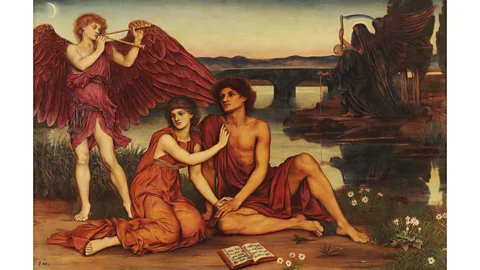 Trustees of the De Morgan Foundation
Trustees of the De Morgan FoundationFor De Morgan, materialism was in opposition to spirituality, and many of her works conflate the pursuit of wealth with death. Crowns, as worn by the winged serpents in Death of the Dragon, are a repeated motif denoting greed and miserliness. In Earthbound (1897), an avaricious king in a gold cloak patterned with coins is about to be overwhelmed by the angel of death, while in The Barred Gate (c.1910-1914), a similar figure is denied entry to Heaven.
With the future so uncertain, De Morgan places the importance of spiritual fulfilment and happiness at the centre of much of her work. In Blindness and Cupidity Chasing Joy from the City (1897), for example, "Cupidity" is personified as a crowned figure clutching treasures who is driving away "Joy" in the form of an angel. Here, as in Death of the Dragon, the central characters are chained, suggesting trapped souls.
In The Prisoner (1907-1908), the barred window and a woman's chained wrists make captivity a metaphor for gender inequality, hinting at the De Morgans' support for universal suffrage (Evelyn was a signatory of at least two important petitions, while her husband was vice-president of the Men's League for Women's Suffrage). The theme recurs in Luna (1885), where the rope-bound body of a moon goddess, a mythological figure of feminine power, functions as a metaphor for a woman's struggle to influence her own destiny.
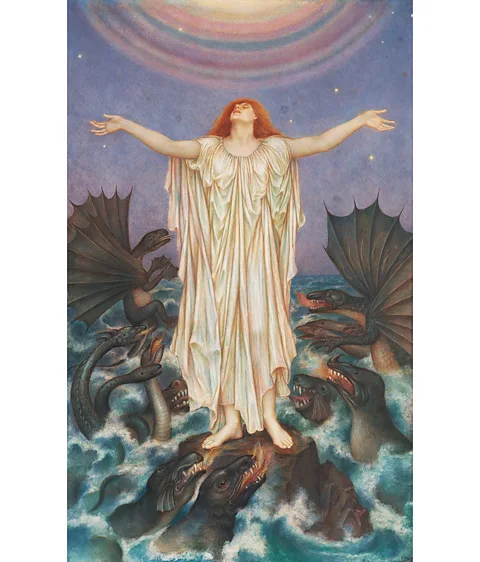 Trustees of the De Morgan Foundation
Trustees of the De Morgan FoundationChristened "Mary", Evelyn later adopted her then-gender-neutral middle name, as women's art was not taken seriously. "She wanted to be considered on the same level as her male peers," says McMeakin. "We can assume a huge degree of self-possession and determination in her desire to become a professional artist," she adds, making the point that even De Morgan's mother opposed her career choice.
Technically, De Morgan was also a pioneer. She experimented with burnishing and rubbing gold pigment into her works to add depth and interest, and explored new painting techniques invented by her husband, made by grinding colours with glycerine and spirit. Stylistically, she was also ahead of her time. The unconventional use of pinks and purples, and the bold rings of rainbow-coloured light, prefigure the psychedelic painting styles of the 1970s, while her terrifying monsters would not look out of place in contemporary fantasy art.
While art history has tended to paint women as virgin mothers, objects of beauty or temptresses, De Morgan's specifically female perspective recasts them as figures of hope that augur an alternative, brighter future. In Lux in Tenebris (light in darkness) (1895), for example, the female figure holds an olive branch in her right hand, offering a pathway to peace. In Death of the Dragon, the angel is surrounded by a magnificent rainbow: a symbol (along with the sky) of joy that denotes spiritual fulfilment and freedom, as well as the promise of an afterlife.
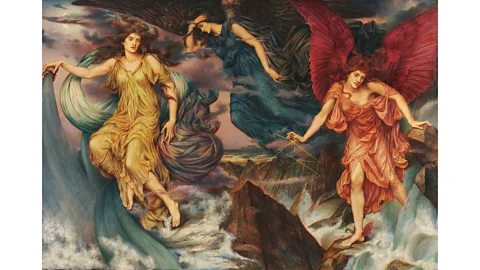 Trustees of the De Morgan Foundation
Trustees of the De Morgan FoundationIt's a mistake to think of works such as Death of the Dragon as "completely bleak", argues McMeakin, noting that "often with [her] apocalyptic scenes, there is a glimmer of hope, or a part of the painting that is calm". In many ways, Death of the Dragon is optimistic, expressing a sense that the war – the metaphorical dragon – is nearing its end, and that good can overcome evil. In this existential battle, De Morgan saw a place for her work. When she was aged just 17, she chastised herself for not painting enough. "Art is eternal, but life is short," she wrote in her diary. "I will make up for it now, I have not a moment to lose."
Evelyn De Morgan: The Modern Painter in Victorian London is at the Guildhall Art Gallery, London until 4 January 2026.
--
If you liked this story sign up for The Essential List newsletter, a handpicked selection of features, videos and can't-miss news, delivered to your inbox twice a week.
